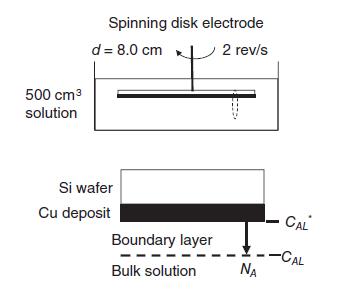A rotating disk shown in the figure (at right) is used to plate a thin film of
Question:
A “rotating disk” shown in the figure (at right) is used to plate a thin film of copper onto a silicon wafer by an electroless plating process at 25 C. The disk is 8.0 cm in diameter and rotates at a speed of 2.0 rev/s. The plating bath liquid volume is 500 cm3. In the electroless plating process, copper metal is deposited on a surface without an applied electrical potential. Instead, copper is deposited on a surface by the reduction of an alkaline solution containing copper (II) ions (Cu+2) stabilized by chelation with ethylene-diamine-tetra acetic acid (EDTA), using formaldehyde (CH2O) dissolved in solution as the reducing agent. The overall reaction stoichiometry is

where Y represents the EDTA chelation agent. In a large excess of chelation agent, formaldehyde, and NaOH, the surface reaction for reduction of Cu+2 is first order with respect to the dissolved copper concentration, with surface rate constant of ks 3.2 cm/s at 25 C. The kinematic viscosity of liquid water is 0.01 cm2/s at 25 C. The diffusion coefficient of Cu+2 is 1.20 10–5 cm2/s at 25 C and infinite dilution. The density of copper is 8.96 g/cm3.
a. What is the convective mass-transfer coefficient (kL) for copper ion diffusion across the liquid boundary layer formed by the spinning disk?
b. Develop a model to describe the flux of Cu+2 from the bulk solution to the rotating disk surface that accounts for the rate of surface reaction. What is the rate of copper deposition (mol/cm2/s) if the Cu+2 concentration is 0.005 gmole/L? Which process is controlling, surface reaction or boundary-layer diffusion?
c. Develop an unsteady-state material balance model to describe the depletion of copper ions in solution with time. How long will it take to deposit a 2.0μm solid thin film of Cu0, if the initial Cu+2 concentration is 0.005 gmole/L and there is initially no copper deposited on the surface? Clearly state all assumptions.

Step by Step Answer:

Fundamentals Of Momentum Heat And Mass Transfer
ISBN: 9781119723547
7th Edition
Authors: James Welty, Gregory L. Rorrer, David G. Foster





